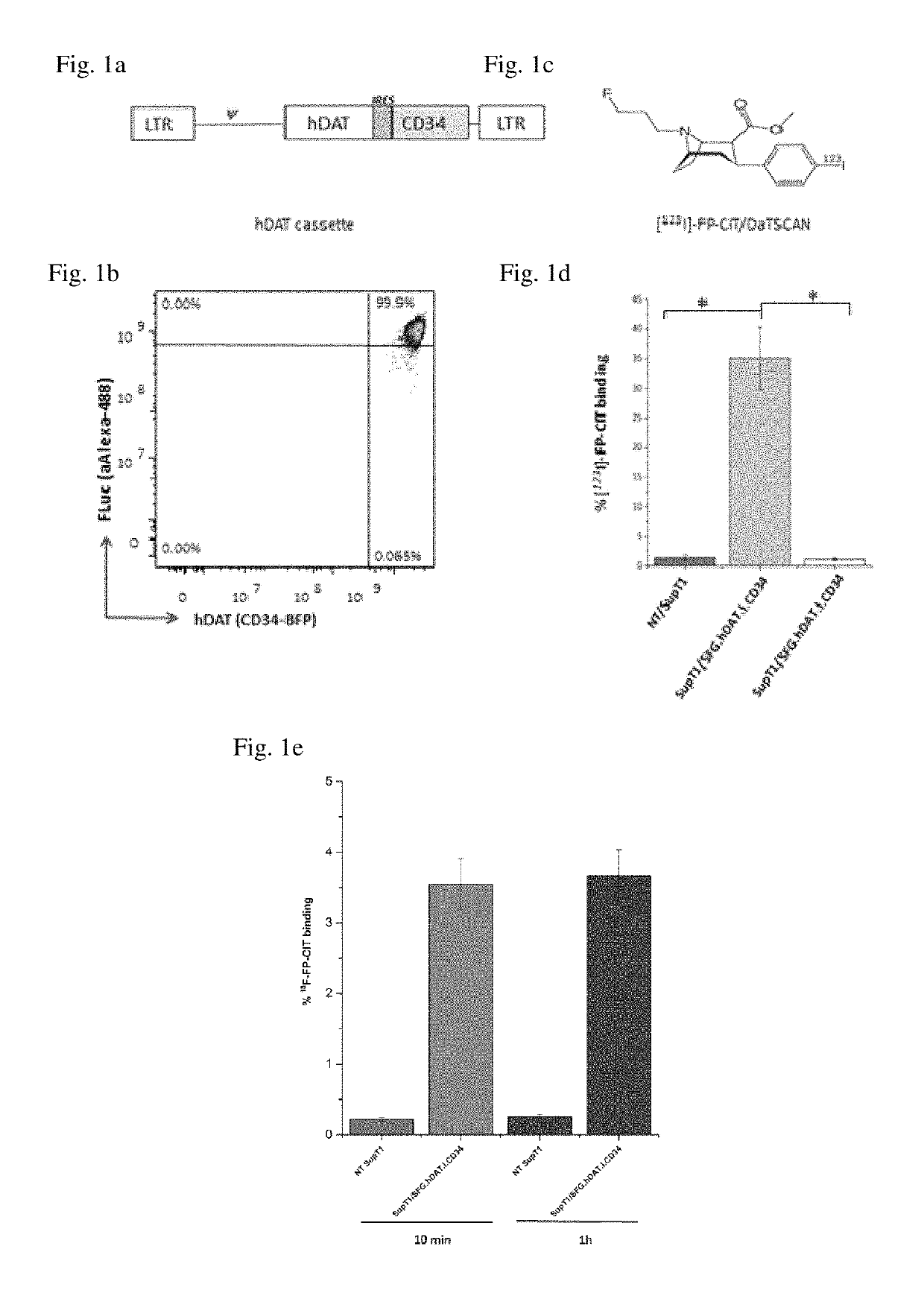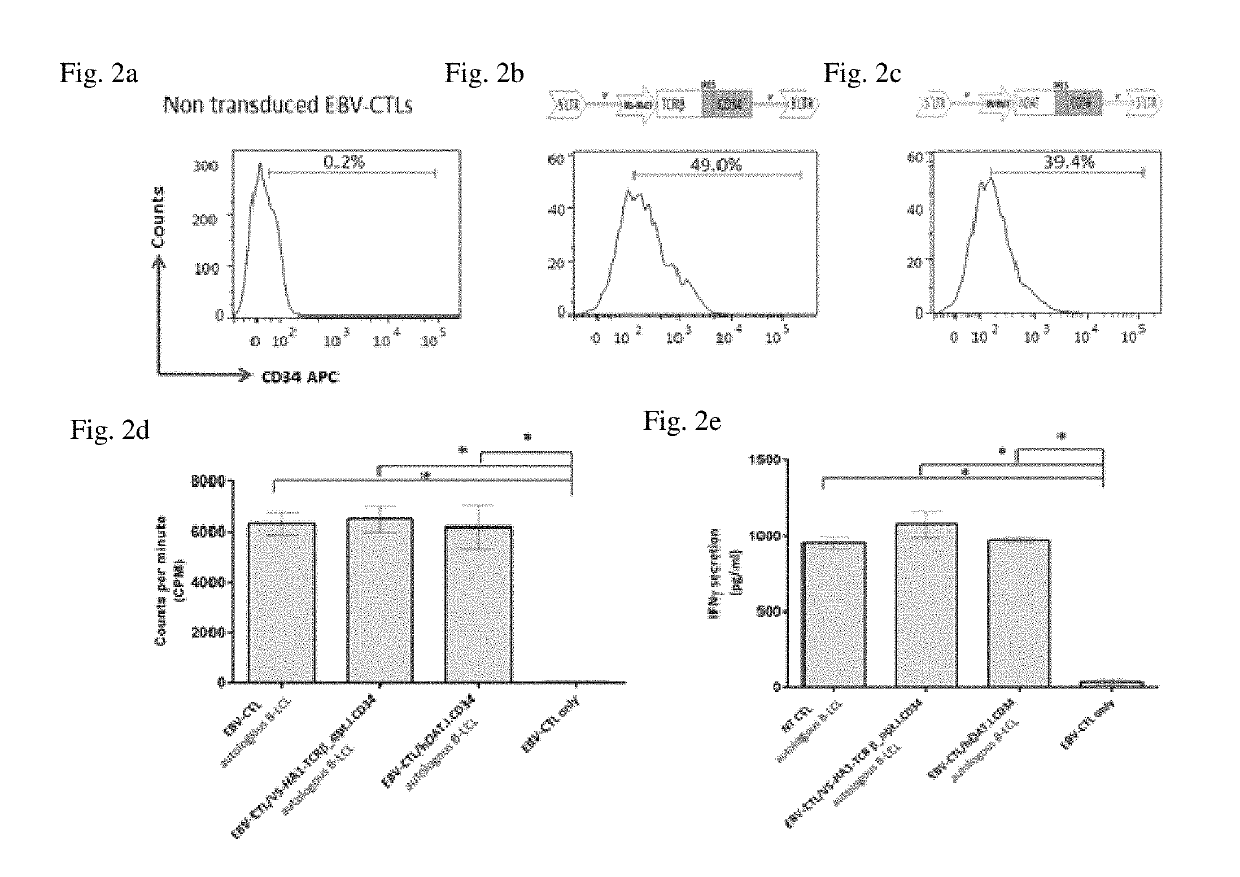Detecting a therapeutic cell
a technology of therapeutic cells and t cells, which is applied in the field of methods and reagents, can solve the problems of unclear fecundity of therapeutic t cells in clinical studies, inability to translatable or clinically validate the tracking of therapeutic t cells in the cns, and inability to detect t cells in the brain. to achieve the effect of longevity and fecundity of therapeutic cells
- Summary
- Abstract
- Description
- Claims
- Application Information
AI Technical Summary
Benefits of technology
Problems solved by technology
Method used
Image
Examples
example 1
l Expression and Binding of Dopamine Active Transporter (DAT) in T-Cells
[0223]To determine the potential for utilising a human DAT (hDAT) reporter to image T-cells using [123I]-FP-CIT, a retroviral vector (SFG.hDAT.I.CD34) encoding both hDAT and CD34 genes was constructed (FIG. 1a) and used to transduce SupT1 cell line. The SupT1 cell line is a CD4+ human T-cell line with tumorigenic properties and stable transduction has been previously demonstrated with no significant reduction in the expression of introduced genes8. Flow analysis of the SupT1 / SFG.hDAT.I.CD34 cells indicated a transduction efficiency of 20-25% and cells were subsequently selected by CD34 expression to 99% purity using FACS (FIG. 1b).
[0224]Binding of [123I]-FP-CIT (FIG. 1c) to hDAT reporter cells was demonstrated by co-incubation of tracer with SupT1 / SFG.hDAT.I.CD34 cells and compared against control non-transduced (NT) SupT1 cells. The percentage [123I]-FP-CIT binding was 25 fold greater (FIG. 1d) in SupT1 / SFG.hDA...
example 2
xpressing hDAT Retain Proliferative and IFN-γ Release Ability
[0225]Primary T cells, EBV-specific CTLs were engineered with hDAT to study any effect the reporter may have on the proliferation and cytokine release. EBV-CTLs were transduced with hDAT (EBV-CTL / SFG.hDAT.I.CD34) or a control vector encoding a HA1 T cell receptor (EBV-CTL / SFG.V5-HA1-TCRβ_opt.I.CD34) and the proliferative and IFN-γ release ability was compared to non-transduced EBV-CTLs (NT / EBV CTLs). The transduction efficiency was 39.4% in EBV-CTL / SFG.hDAT.I.CD34 (FIG. 2b), 49.0% in EBV-CTL / SFG.V5-HA1-TCRβ_opt.I.CD34 (FIG. 2c) in comparison to NT / EBV CTLs (FIG. 2a). There was no significant (p>0.05) difference in the functional capabilities between NT / EBV CTLs, EBV-CTL / SFG.hDAT.I.CD34 and EBV-CTL / SFG.V5-HA1-TCRβ_opt.I.CD34 cells upon stimulation with B-LCLs indicating EBV-CTL / SFG.hDAT.I.CD34 cells were able to retain their proliferative and IFN-γ release ability at levels comparable to control cells.
Example 3—In Vivo Eval...
example 4
n of Variant hDATs
[0230]The inventors generated a range of constructs expressing hDAT and hDAT variant proteins. Assessment of the binding capabilities of the hDAT and variant hDAT proteins demonstrated that a hDAT protein in which the last two transmembrane domains had been deleted was unable to bind [123I]-FP-CIT (FIG. 7).
[0231]In contrast truncated hDAT proteins lacking either the 49 N-terminal amino acids or the 18 C-terminal amino acids compared to wild-type hDAT were able to bind [123I]-FP-CIT (FIG. 7—dhDATopt and dhDATopt-d 1).
[0232]In addition hDAT tagged with RQR8 and hDAT including a D313N mutation were able to bind increased levels of [123I]-FP-CIT compare to wild-type hDAT (FIG. 7—RQR8-hDAT and hDAToptD313N).
PUM
| Property | Measurement | Unit |
|---|---|---|
| volume | aaaaa | aaaaa |
| acquisition time | aaaaa | aaaaa |
| acquisition time | aaaaa | aaaaa |
Abstract
Description
Claims
Application Information
 Login to View More
Login to View More - R&D
- Intellectual Property
- Life Sciences
- Materials
- Tech Scout
- Unparalleled Data Quality
- Higher Quality Content
- 60% Fewer Hallucinations
Browse by: Latest US Patents, China's latest patents, Technical Efficacy Thesaurus, Application Domain, Technology Topic, Popular Technical Reports.
© 2025 PatSnap. All rights reserved.Legal|Privacy policy|Modern Slavery Act Transparency Statement|Sitemap|About US| Contact US: help@patsnap.com



